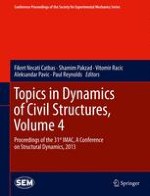2013 | OriginalPaper | Buchkapitel
45. Optimal Sensor Placement for Structural Health Monitoring of Power Transmission Tower-Line Systems
verfasst von : José Antonio Vergara, Rafael Castro-Triguero, David Bullejos, Rafael Gallego, Diego Zamora
Erschienen in: Topics in Dynamics of Civil Structures, Volume 4
Verlag: Springer New York
Aktivieren Sie unsere intelligente Suche, um passende Fachinhalte oder Patente zu finden.
Wählen Sie Textabschnitte aus um mit Künstlicher Intelligenz passenden Patente zu finden. powered by
Markieren Sie Textabschnitte, um KI-gestützt weitere passende Inhalte zu finden. powered by
